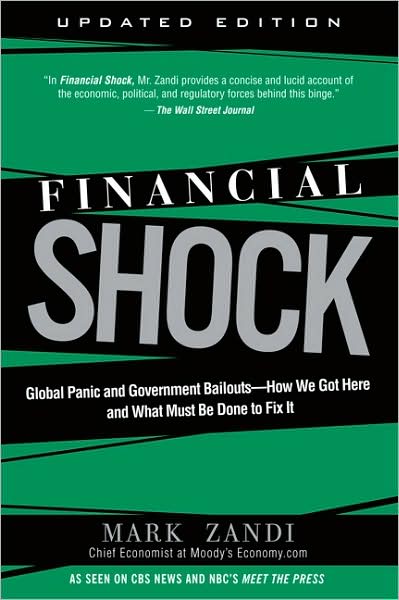Book Review: Bailout Nation

Also, the writing is simple to understand, but you don’t get a simplistic view of who was to blame, similar to my Blame Game series.? There are a lot of culprits who took advantage of the boom times, leaving themselves and all of us more vulnerable in the eventual bust.
Barry begins the book by describing the normal temptation of nations to bail out large private interests when things go south.? The US resisted these temptations until the creation of the Federal Reserve, an quasi-public entity that I like to say was created so that the Treasury Department could take actions that would otherwise be unconstitutional.
He then describes early bailouts (Lockheed, Chrysler) that set the pattern for what will come later.? But the greater factor that Barry describes are the implicit bailouts where Greenspan threw liquidity at every crisis, which avoided the reconciliation of bad lending decisions.? Great examples include: commercial mortgages in the early ’90s, Mexico and mortgages in 94, Russia/Asia/LTCM in 98, and the Nasdaq in 2000-2.
Liquidity was never absent in the Greenspan era, and debts built up, realizing that since the Fed would protect them, why not take more risk?
The idea backfired on the Fed.? Investors took more risk because they thought the Fed would protect them, and so they leveraged up on investments at narrow spreads over risk-free investments in order to meet return targets.
Any policy that reduces risk-consciousness is a bad one.? Ditto for those that say follow the crowd.
As I have said before, if a country has fiat money, it must also regulate credit.? Conditions in the banking sector deteriorated through the Bush Jr., administration, leading to the credit crises we are seeing today.? Conservative, it is not.
Barry also details the crisis in 2008 as it unfolded, and questions the motives of parties involved, or, why they didn’t act earlier.
Personal Notes
- The 1996 Greenspan comment on “irrational exuberance” is treated well by Barry.? Greenspan was long on words but short on deeds.
- Barry could have done more with the Banking crisis 1989-93, which prompted the aggressive Fed policy which is similar to today’s policy.
- Big as the Federal Reserve is, they certainly did not do their regulatory job with respect to lending terms.
- Barry agrees with me that the CPI is understated.
- On AIG, I would note that AIG Financial Products was not the only problem, though it was the biggest.? The domestic life companies had real issues.
- I was gratified to see how many experts that Barry cited favored increased immigration to the US of those that are wealthy.
- Finally, on the second to last page, he quotes an obscure economist with a weirdly-named blog.? Hey Felix, yes, he quoted few bloggers, but you missed this one.
All in all, a great book.? If there is a better one to describe the crisis, I will be very surprised.
If you want to buy it you can buy it here:?? Bailout Nation: How Greed and Easy Money Corrupted Wall Street and Shook the World Economy
For one final note, I love the cover of the book where they morph the Wall Street Bull into a pig.? It symbolizes the era we are in in.







 No, it’s altogether too easy, which leads to complacency.? Consider the
No, it’s altogether too easy, which leads to complacency.? Consider the 